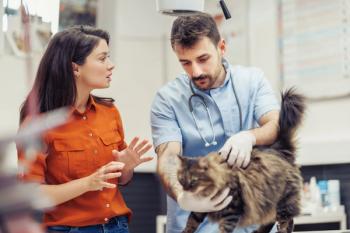
Back to basics
How are we adapting to the veterinarian labor shortage? By having effective teams.
How are we adapting to the veterinarian labor shortage? By having effective teams.
As this shortage compounds, we are seeing pressure on the rising cost of professional help.
Certainly one reason for the labor shortage is that most of us are unwilling to work the James Herriot style of medicine-available 24 hours a day, seven days a week.
Another issue that has caught me off guard is that many new graduates do not know how to clean a cage, perform many of the basic nursing duties, set up for a dental or activate an infusion pump.
And scarier yet, many veterinarians have no interest in such duties and adopt the "I do not do technician stuff..." attitude.
Table 1.
One way to solve the issue of skill weakness and motivation has been 100 percent compensation pay.
Solving the problem
Consider this example: A 14-year-old Irish Setter with geriatric vestibular syndrome gets $500 worth of X-rays, including hip films, $300 in lab tests and $100 in medications.
Certainly this true story is a dramatic example, yet this salary technique has become necessary for some businesses to survive.
It has been said that when incentive pay rises over 25 percent of the entire compensation package, then human behavior is affected.
Human HMOs and such incentive programs have clearly compromised human health care; too bad veterinary medicine is following suit.
Should anyone not believe the affect on human medicine? Read the medical and financially linked data provided in the last 15 years in the Wall Street Journal, the New England Journal of Medicine and the Journal of the American Medical Association.
Don't believe?
Such studies are not widely available for veterinary medicine, but honesty dictates that veterinarians are humans as are most medical doctors.
A basic rule of management is "do not tempt good people...," and, at the least, the 100 percent incentive pay is a temptation to both the employer and employee. (Like full page ads in the telephone book.)
Table 2.
So, what is the conscientious professional employer to do to address the veterinary labor shortage?
So, what to do?
Make sure that the practice has sufficient support staff to provide the services to the client.
Most of the veterinary management world now has accepted that gross veterinary revenue is linear with the numbers of support staff. Specifically, the national average of production per veterinarian is about $250,000, but doubles as numbers of trained staff are doubled.
A veterinarian who learns to delegate can generate $500,000.
With these numbers a practice can provide a good health plan and fair base pay, plus a humane incentive program.
Who are the staff members needed to achieve a balanced approach to providing veterinary services in the "sequencing" era? (Sequencing is defined as when a worker takes a few years off, possibly to have children, or pursue advanced education. See DVM Newsmagazine, October 2003, p. 46.)
Defining teams
Three types of folks are needed in a typical companion animal practice. We call them teams, and they include the technical team, front office team and infrastructure team.
The technical team (T-Team) responsibility rests specifically with patient care duties: cleaning cages, administering medication, acquiring laboratory data, supporting the veterinarian and, most importantly, keeping patients comfortable.
Table 3.
The front office team (FO-Team) responsibility includes admitting patients, releasing patients, figuring fees, answering the telephone, retrieving and filing medical records, and most importantly, keeping clients-the customers - happy.
The infrastructure team's (I-Team) responsibility includes practice management personnel, building and equipment maintenance, auditing, recall system, computer system responsibility, human resource duties, including health insurance issues and government paperwork.
A balance and cooperation is needed between these teams to assure compliance with all legal protocols associated with government rules and animal care ethics.
Our studies suggest that one FO-Team member is needed for each T-Team member and one infrastructure person is needed per 10 people, the 10th being the veterinarian(s).
The leader of the practice is the trump card that we see in practices that are thriving, in the eyes of the client and patient.
Trump card
The leader might be a veterinarian or a motivated support staff person.
The leader becomes the energy, the image, the heart and the engine of the practice.
For a $600,000 grossing practice as we present it here, two veterinarians can provide these services or one veterinarian can generate these veterinary services with the same staff.
Table 1 outlines an effective basic budget for the three-team practice. Table 2 outlines an effective professional compensation package with ties to direct patient care.
Support staff compensation (Table 2) illustrates pay priorities for the three-team practice. The central issue is that a living wage is key to retaining and attracting excellent staff members.
The typical distribution of staff (Table 3) provides a basic outline of staff positions needed to complete a wide array of client and patient care needs in the traditional veterinary practice.
As I discussed in my October column on sequencing, the profession is unlikely to find a whole bushel of veterinarians up to managing 40 patients per day, 200 days a year.
Thus, the heart of the sequencing scenario is the leader and the support staff. The staff and the leader are always present for the client, and they become the image and the face of the practice in the community.
With the three-team model everyone wins-client, patient, practice, veterinarian and support staff.
Newsletter
From exam room tips to practice management insights, get trusted veterinary news delivered straight to your inbox—subscribe to dvm360.





